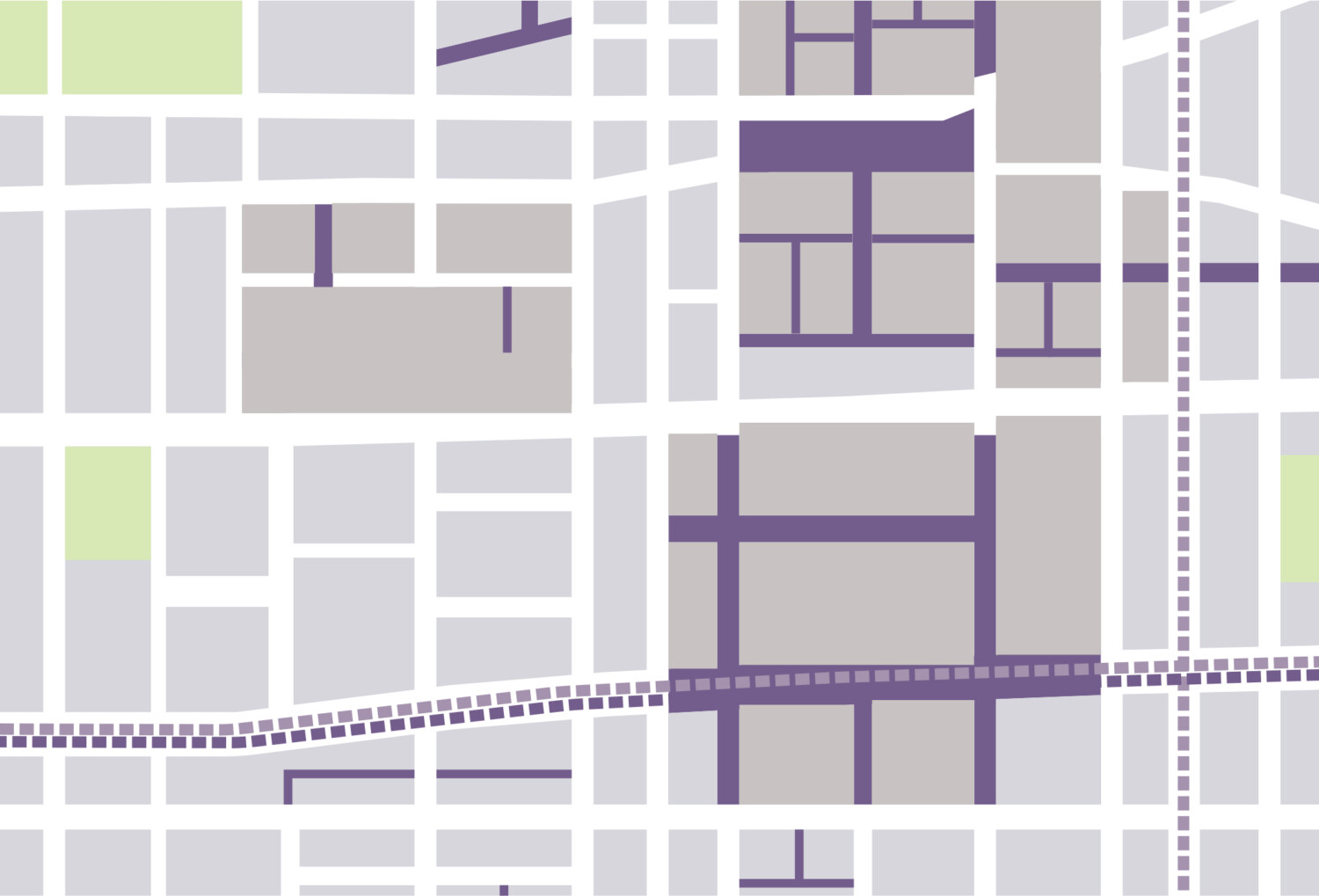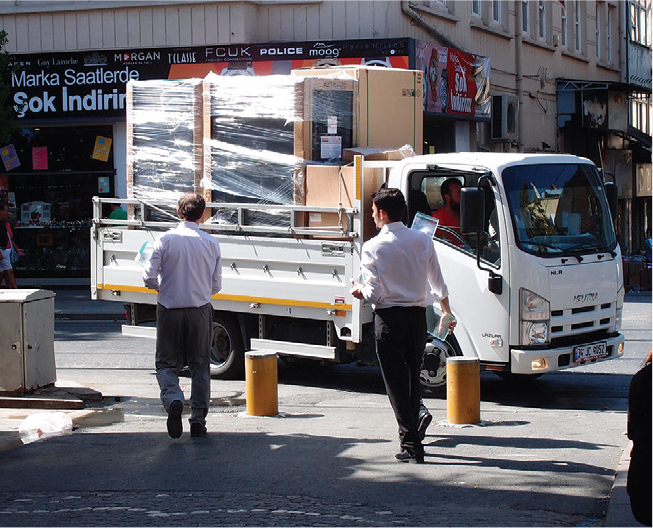-
About Streets
- Introduction
- Defining Streets
-
Shaping Streets
- The Process of Shaping Streets
- Aligning with City and Regional Agendas
- Involving the Right Stakeholders
- Setting a Project Vision
- Communication and Engagement
- Costs and Budgets
- Phasing and Interim Strategies
- Coordination and Project Management
- Implementation and Materials
- Management
- Maintenance
- Institutionalizing Change
- Measuring and Evaluating Streets
-
Street Design Guidance
- Designing Streets for Great Cities
- Designing Streets for Place
-
Designing Streets for People
- Utilities and Infrastructure
- Operational and Management Strategies
- Design Controls
-
Street Transformations
- Streets
-
Intersections
- Intersection Design Strategies
- Intersection Analysis
- Intersection Redesign
- Mini Roundabout
- Small Raised Intersection
- Neighborhood Gateway Intersection
- Intersection of Two-Way and One-Way Streets
- Major Intersection: Reclaiming the Corners
- Major Intersection: Squaring the Circle
- Major Intersection: Cycle Protection
- Complex Intersection: Adding Public Plazas
- Complex Intersection: Improving Traffic Circles
- Complex Intersection: Increasing Permeability
- Resources
Global Street Design Guide
-
About Streets
- Introduction
- Defining Streets
-
Shaping Streets
Back Shaping Streets
- The Process of Shaping Streets
- Aligning with City and Regional Agendas
- Involving the Right Stakeholders
- Setting a Project Vision
- Communication and Engagement
- Costs and Budgets
- Phasing and Interim Strategies
- Coordination and Project Management
- Implementation and Materials
- Management
- Maintenance
- Institutionalizing Change
-
Measuring and Evaluating Streets
Back Measuring and Evaluating Streets
-
Street Design Guidance
-
Designing Streets for Great Cities
Back Designing Streets for Great Cities
-
Designing Streets for Place
Back Designing Streets for Place
-
Designing Streets for People
Back Designing Streets for People
- Comparing Street Users
- A Variety of Street Users
-
Designing for Pedestrians
Back Designing for Pedestrians
- Designing for Cyclists
-
Designing for Transit Riders
Back Designing for Transit Riders
- Overview
- Transit Networks
- Transit Toolbox
-
Transit Facilities
Back Transit Facilities
-
Transit Stops
Back Transit Stops
-
Additional Guidance
Back Additional Guidance
-
Designing for Motorists
Back Designing for Motorists
-
Designing for Freight and Service Operators
Back Designing for Freight and Service Operators
-
Designing for People Doing Business
Back Designing for People Doing Business
-
Utilities and Infrastructure
Back Utilities and Infrastructure
- Utilities
-
Green Infrastructure and Stormwater Management
Back Green Infrastructure and Stormwater Management
-
Lighting and Technology
Back Lighting and Technology
-
Operational and Management Strategies
Back Operational and Management Strategies
- Design Controls
-
Street Transformations
-
Streets
Back Streets
- Street Design Strategies
- Street Typologies
-
Pedestrian-Priority Spaces
Back Pedestrian-Priority Spaces
-
Pedestrian-Only Streets
Back Pedestrian-Only Streets
-
Laneways and Alleys
Back Laneways and Alleys
- Parklets
-
Pedestrian Plazas
Back Pedestrian Plazas
-
Pedestrian-Only Streets
-
Shared Streets
Back Shared Streets
-
Commercial Shared Streets
Back Commercial Shared Streets
-
Residential Shared Streets
Back Residential Shared Streets
-
Commercial Shared Streets
-
Neighborhood Streets
Back Neighborhood Streets
-
Residential Streets
Back Residential Streets
-
Neighborhood Main Streets
Back Neighborhood Main Streets
-
Residential Streets
-
Avenues and Boulevards
Back Avenues and Boulevards
-
Central One-Way Streets
Back Central One-Way Streets
-
Central Two-Way Streets
Back Central Two-Way Streets
- Transit Streets
-
Large Streets with Transit
Back Large Streets with Transit
- Grand Streets
-
Central One-Way Streets
-
Special Conditions
Back Special Conditions
-
Elevated Structure Improvement
Back Elevated Structure Improvement
-
Elevated Structure Removal
Back Elevated Structure Removal
-
Streets to Streams
Back Streets to Streams
-
Temporary Street Closures
Back Temporary Street Closures
-
Post-Industrial Revitalization
Back Post-Industrial Revitalization
-
Waterfront and Parkside Streets
Back Waterfront and Parkside Streets
-
Historic Streets
Back Historic Streets
-
Elevated Structure Improvement
-
Streets in Informal Areas
Back Streets in Informal Areas
-
Intersections
Back Intersections
- Intersection Design Strategies
- Intersection Analysis
- Intersection Redesign
- Mini Roundabout
- Small Raised Intersection
- Neighborhood Gateway Intersection
- Intersection of Two-Way and One-Way Streets
- Major Intersection: Reclaiming the Corners
- Major Intersection: Squaring the Circle
- Major Intersection: Cycle Protection
- Complex Intersection: Adding Public Plazas
- Complex Intersection: Improving Traffic Circles
- Complex Intersection: Increasing Permeability
- Resources
- Guides & Publications
- Global Street Design Guide
- Designing Streets for People
- Designing for Freight and Service Operators
- Freight Networks
Freight Networks
Street networks must allow for an overlapping set of functions that serve multiple users, but not every street must be designed for large vehicles moving goods through the city. Facilitating reliable delivery and freight movement is essential to economic growth, but it must be accommodated while managing congestion and without sacrificing vibrant streets.
Creating a network to accommodate freight vehicles can increase efficiency while mitigating air and noise pollution. Design local streets for smaller vehicles and infrequent access by large trucks.
Safety is fundamental to determine how large vehicles should move through a street network. Streets should be designed for the most vulnerable user rather than the largest possible vehicle.
Access Routes
Large vehicles delivering goods typically feed in from access points to regional highways. Exposure to emissions and noise pollution from large volumes of truck traffic has been tied to public health challenges such as high asthma rates and increased stress levels. These routes should be planned to avoid residential neighborhoods and areas with heavy pedestrian and cycle volumes.
Distribution Networks
Many commercial locations in urban areas require frequent delivery and pick-up services. These areas present conflicts between high pedestrian volumes and large delivery trucks. Designate urban areas where goods may be transferred from large vehicles to smaller vehicles appropriate for the scale of city streets.
Limited Access
Limit access for commercial delivery to off-peak or nighttime hours, when streets are less busy. Avoid areas with heavy nighttime pedestrian activity.
Loading Zones
Provide dedicated loading bays to prevent delivery vehicles from blocking sidewalks or cycle lanes. Loading zones should be located on each block where deliveries will be made, and should be time- or permit-restricted.
Street Cleaning Vehicles
Maintaining clean streets is an important consideration in neighborhood health, pride, and stewardship. Regular street sweeping can also reduce pollutants and debris entering the watershed. Cleaning-truck dimensions are important, but vehicle sizes should not drive street design. Where separated cycle tracks cannot be serviced by standard vehicles, investing in smaller alternatives is highly recommended.
Fire Trucks and Emergency Vehicles
Large vehicles can access dedicated transit lanes in congested areas and perform turning radii that include multiple travel lanes. Where fire hydrants are provided, ensure appropriate clear space for access.
Oversized Vehicles
Access for oversized vehicles carrying large items can be provided on certain routes. Assume projection over multiple travel lanes, low street furniture, and medians given the infrequency of these types of loads.
Minimizing Conflict
Large vehicles present a safety challenge for vulnerable users such as cyclists and pedestrians, particularly seniors, children, and people with disabilities. Speeds of large vehicles should be kept below 30 km/h in urban areas. Limit turns in high pedestrian areas to minimize conflict, and avoid sharing cycle routes with truck routes where possible.

Freight Networks: Urban streets should provide safe, efficient, and environmentally sustainable networks for moving goods and providing city services. Chosen routes for truck access should minimize impacts to local residents. Street design should reduce conflicts between large vehicles. Restricted delivery times can minimize congestion and balance curb access for loading with other street uses.




Adapted by Global Street Design Guide published by Island Press.
Next Section —